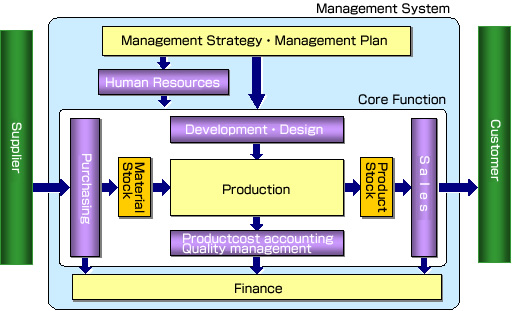Factory Mechanism:Outline
2008.11.11
Framework of Factory Mechanism
Let's take a look at the framework of a Factory Mechanism.

First, the focal point is the site of production. In the figure, it is the part labeled "production". This is where machinery and equipment is placed, where workers are, and where products are processed and produced. It is necessary to purchase materials and parts to be used during "production", from outside. This is the part labeled "purchasing" on the left side of the figure. Some companies may call it "procurement". In an assembly type of factory, the material cost takes up 60% to 80% of the product cost. If the company can manage to procure materials and parts at a low price, the profit rate of the company can go up. In addition, if the procurement of materials and parts is behind schedule, the "production" site cannot make a start on processing. Then, human resources and equipment will be idle.
From this point of view, "purchasing" is work which has a great meaning for a factory.
The company cannot count something as a sale, until when what was produced, has been sold. The "sales" shown on the right side of the figure is in charge of sales. Unless there is an order, the "production" site falls under the situation of so-called "no job" category, and it cannot utilize its capabilities. "Sales" is quite an important part of company management.
This flow of "procurement" →"production"→"sales", the horizontal flow in the figure, is one of the frameworks of a factory. The other framework is "development・design"→"production", the vertical flow. This is the operation to develop products and technology, in order to make production possible at the production site.
Since the market life time of products becomes shorter, and the introduction of new products is required one right after the other, the importance of this vertical framework is becoming stronger than before. Also, in order to compete with cheap imported goods, the upgrading of the products is necessary, and we may say that the capability of "development・design" will determine the future of the company.
Information from "development・design"(product specification・method of productin, etc.) is not only used in "production", but also in "procurement", "sales and services".
It is important to adjust the information, which is held by departments, into lines, however, there seem to be many companies where this doesn't work well. In such a company, it is difficult to understand the profitability of a product in terms of life cycle from when a product was introduced in the market, used, and discarded. In order to improve upon such a weak point, an effort of PLM (product life cycle management) is being advocated.
The above-mentioned two flows, of vertical and horizontal, are the framework of a factory, but it is necessary to monitor if the operation goes smoothly, and to correct the direction of the flows if there is an issue.
"product cost accounting & quallity management" and "finance" in the lower part of the figure is this part. "Product cost accounting & quality management" takes actual data of the production activity, checks if product quality and cost of the product are within the planned criteria, and if there is a problem, give a warning to the responsible person. "Finance" is a structure to report the actual operation results to the stockholders and the revenue authority.
"Management Strategy" on the upper part of the figure is to understand the change of the market environment, and lead the factory in future endeavors. "Human resources" is to secure the required number of employees, improve the morale and skill of employees, in addition, it plays the role of protecting the safety and health of employees.
Not presented in the figure, there are the functions of facility management and information systems in general.
"Mechanism of a Factory with Illustrations"
Published by Nippon Jitsugyo Publishing.
by Mitsuo Matsubayashi and Hiroshi Watabe.
Members of Waku Consulting Co. Ltd
Please click here for the web site of Waku Consulting.
